telegraph
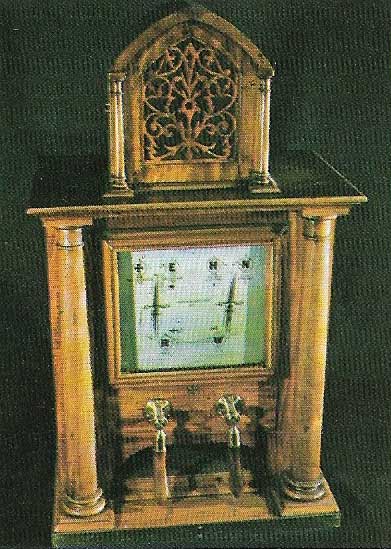
Figure 1. The world's first commercial telegraph was the five-wire system set up by Charles Wheatstone and William Cooke in England in 1839. Switch pairs made each needle deflect in either direction.
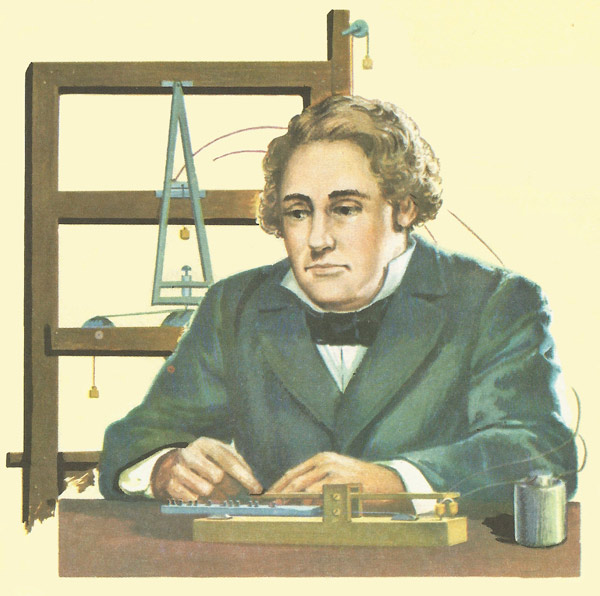
Figure 2. Samuel Morse transmits a message by telegraph. Behind him is the receiver on which the message is recorded.
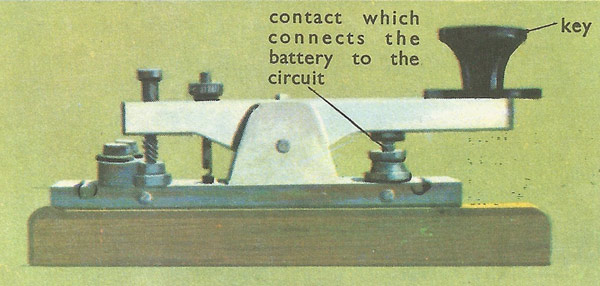
Figure 3. A Morse key is basically a switch. The contacts at the front and rear of the arm can be seen. When the key is depressed contact at the rear is broken and the circuit made instead through the front contact.
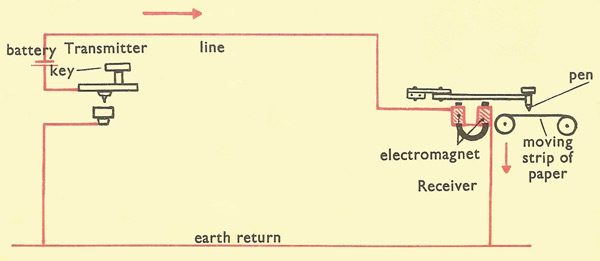
Figure 4. This diagram shows the simplest possible telegraph circuit in which messages can be transmitted in one direction only.
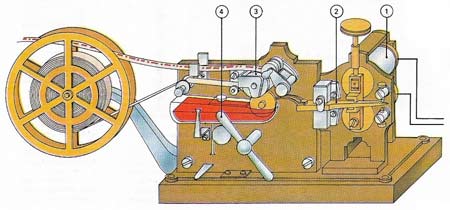
Figure 5. This early Morse receiver-printer is operated by closing the circuit of the transmitter (a simple key). The current energizes the coils (1). The lever (2) is moved by magnetic attraction, bringing the printing disk (3) into contact with the paper tape for the duration of the current. The disk is linked by contact with a roller immersed in a bath of printer's ink. The movement of the paper tape is effected by clockwork wound by the handle (4). It was found that a skilled operator could "read" a buzzer quicker than an inked tape.
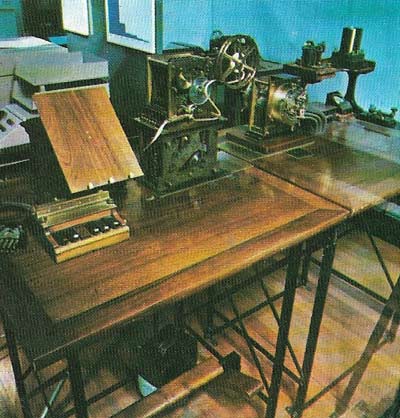
Figure 6. Emile Baudot's multiplex system enabled several telegraph operators to send messages over the same line simultaneously. Each operator's set was connected in turn to the line by a distributor for just enough time to allow transmission of a single letter in the form of a five-unit code. By exact phase synchronization outgoing signals could be correctly separated and "read" on receivers at the other end.
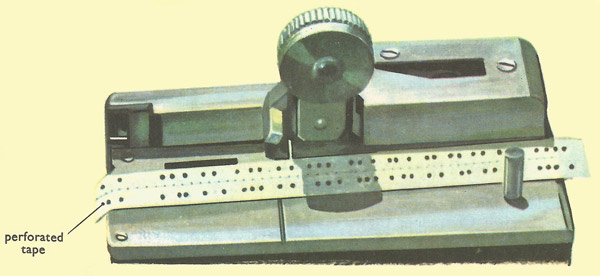
Figure 7. The head of an automatic transmitter used for tape with two lines of holes.
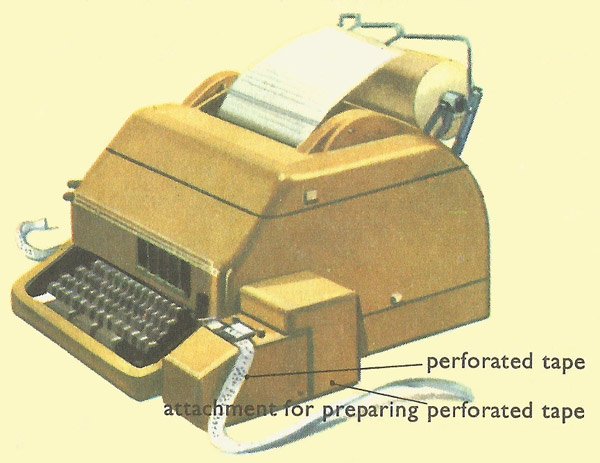
Figure 8. Teleprinter.
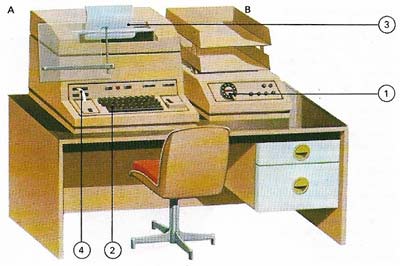
Figure 9. A telex installation comprised a teletypewriter (A) and a dialing unit (B), both often built into a single console. The operator used the dial unit (1) to call the receiver's telex number and then typed the message using conventional typewriter keys (2). Alternatively, the message could be pre-typed on a punched tape (4) and fed in for extra speed in transmission or when a line was free. For checking, the transmitted message was automatically printed, out above (3). When not sending, the equipment was left ready for receiving. A buzzer could alert the receiving operator to an incoming message. If the operator was absent the teletypewriter was automatically activated to reproduce the message on the paper (3). Incoming messages could this be stored in typed form on the machine until the operator returned.
Two hundred years ago or so, messages could only be sent by some form of noise, flare or beacon, or by actually transporting it. It was not until people learned how to send transmit messages by electricity that a whole new era in communications was opened up. A telegraph is an electrical apparatus for sending coded messages.
Early developments
Simple forms of semaphore had long been used, but the transmission of messages beyond the range of sight had to wait until the discovery of electricity. The idea was foreshadowed as early as 1753 by a Scottish doctor, Charles Morrison, in a letter to the Scots Magazine. In 1764 Georges Louis Lesages built and operated an experimental electric telegraph in Geneva using static electricity and an electroscope. The mutual repulsion of a pair of pith balls indicated the presence of an electric charge in a wire connected to them and a separate wire was used for each letter of the alphabet.
At the end of the eighteenth century, Napoleon Bonaparte (1769–1821), who was the first to make use of a systematic telegraph, still had to rely on a visual system invented by a French merchant, Claude Chappe (1763–1805), to receive intelligence reports and send orders to his army.
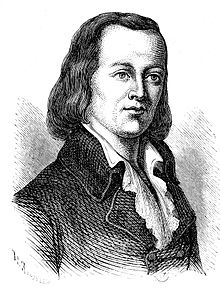 |
| Claude Chappe was a French engineer who, with his brother, Ignace, invented a semaphore telegraph in 1791. During the French Revolutionary Wars they used their telegraph on towers to relay information about the state of the war between France and Austria, this method being much faster than other existing forms of communication. |
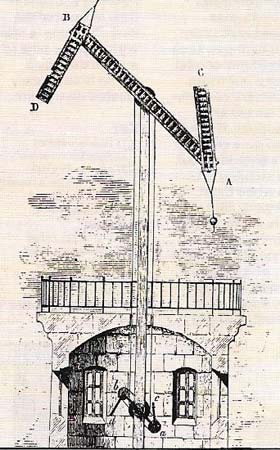 |
| The earliest form of long-distance communication, apart from jungle drums, smoke signal,s and similar crude devices, was the visual semaphore invented by Chappe and used by the French army from 1794. The Chappe telegraph consisted of pairs of hand-operated semaphore arms located on a chain of towers built on the tops of hills within sight of each other. |
Single-wire telegraphy
It was not until 1816 that a single-wire telegraph was invented by an Englishman, Francis Ronalds (1788–1873). He set up disks turned by clockwork at each end of the wire. Each disk was initialed with the alphabet round its rim and, as the desired letter aligned with a pointer, the sender's wire was connected to an electroscope. With the disks synchronized, a person at the other end of the wire could note the letter indicated each time the wire received a charge.
Ten years later an American, Harrison Gray Dyer, built the first practical electrical telegraph by using the recently invented voltaic cell (battery) and a chemical solution that indicated the presence of an electric current by the formation of bubbles at two electrodes. Dyer sent messages along 12.5 kilometers (8 miles) of wire laid in Long Island, New York, using the earth to complete the circuit.
The final step in the evolution of the electric telegraph came in 1831 when another American, Joseph Henry (1797–1878), replaced Dyer's electrolytic indicator with an electric bell, using the principle of electromagnetism discovered in 1819 by the Danish physicist Hans Christian Oersted (1787–1851). Henry used a code to indicate the different letters of the alphabet.
Two Englishmen, William Fothergill Cooke (1806–1879) and Charles Wheatstone (1802–1875), designed, patented, and installed the world's first commercial telegraph (Figure 1). It used six wires and five pointers, which moved in pairs to indicate letters in a diamond-shaped array. It was first tested in 1837 between Euston and Camden Town on the London-Birmingham railway and installed two years later, between Paddington and West Drayton, for the Great Western Railway.
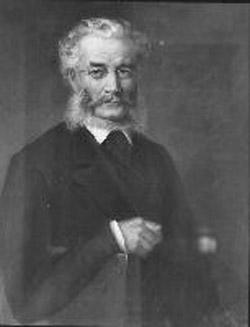 |
| William Cooke was a British electrical engineer who collaborated with the physicist Charles Wheatstone to develop the first commercial electric telegraph in 1837. In 1845 they patented a single-needle apparatus. |
Morse code and later development
Up to this time each inventor had devised his own means of coding messages. It was an American inventor and painter, Samuel Morse (1791–1872), who first recognized the practical and commercial importance of devising a standard code (Figure 2). He demonstrated his own code in 1837. In partnership with Alfred Vail, and helped by Joseph Henry, he patented a telegraph system using revised Morse code in the US. The first intercity line was inaugurated in 1844. At first the receiver embossed or printed the code symbols but this was soon replaced by a sounding device. In 1858 Wheatstone invented a high-speed automatic Morse telegraph, using punched paper tape in transmission.
Morse code eventually made possible the development of electric telegraphs throughout the world. Consisting essentially of a single wire, the telegraph circuit was completed by a battery and key between the wire and the earth at the sending end (Figure 3), and an electromagnetic sounder between the wire and the earth at the receiving end.
The laying of submarine cables was a natural development of the electric telegraph. A connection across the English Channel in 1850 encouraged engineers to attempt the more difficult task of laying a cable across the Atlantic. Success came in 1858 when a cable was laid from Ireland to Newfoundland, although a reliable link was not established until 1866.
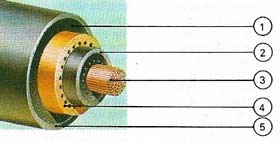 |
| A typical early submarine cable was made up of a stranded copper conductor (3), usually of wires or copper tapes woven round a stout central strand; an insulating layer (2), originally of gutta percha; a layer of jute fiber (4) with galvanized steel wires embedded in it (for strength); another layer (1) of compounded jute; and an outer waterproof layer (5) tough enough to withstand chafing. |
Because wire is expensive inventors soon turned their minds to ways of sending a number of messages simultaneously along a single wire. The breakthrough came in 1872 when a Frenchman, Jean-Maurice-Émile Baudot (1845–1903), designed an instrument which, when fully developed, could interlace six messages and unscramble them (Figure 6). His multiplexing system enabled the sharing of time on each transmission line between several operators. Baudot's system, in which every letter consisted of five pulses (or absence of pulses), was used successfully for about 50 years until replaced by a more sophisticated frequency division multiplex, invented in the 1890s by an American, Elisha Gray (1835–1901).
To reduce the time spent coding and decoding messages much effort was given, over many years, to the invention of an automatic printing telegraph. David Hughes (1831–1900), an American professor of music, built the first practical printing telegraph in 1854 (Figure 5), but it, too, was slow. In 1921 a Russian, N. P. Trusevich, invented what is called the "start-stop" system and the modern teleprinter became possible. The new invention solved the problem of keeping the receiving machine perfectly synchronized with the sending machine when the operator's typing speed varied slightly from letter to letter (Figure 8). The modern teleprinter, using the five-unit code, could transmit up to 13 characters a second when working from punched paper tape which the operator first prepards, typing at their own speed. Telex (Figure 9) enabled up to 26 teleprinter messages to be carried on a single telephone cable. Photo-telegraphy completed the range of modern telegraphic communications.
Science of early telegraphy
Telegraphy is based on the sending of electrical impulses through wires. An electric current can easily be sent through a wire by a battery, and the duration of the current can be controlled by switching the battery on and off. The wires at the other end can be connected to a receiver – an electromagnetic instrument designed either to make a sound like a buzz or a click, to ring a bell, to alter the direction of a magnetic needle, or draw a line.
The first ever telegraph system was set up in London in 1837 by Charles Wheatstone. His earliest system was very cumbersome, using five different lines, and he soon replaced it with a single-line system. The receivers of these early systems worked by deflecting magnetic needles.
While these advances were being made in Britain, Samuel Morse was developing his own telegraph. In his apparatus, which was first used in 1844, the electric current worked an electromagnet that caused a pencil to mark a line on a moving piece of paper. By regulating the length of the electrical impulses, Morse was able to produce long and short marks. He invented a code in which combinations of these long and short marks, known as dots and dashes, represented the letters of the alphabet.
A simple telegraph set consists of a battery to provide the electric current, a wire or line to carry it to another place, a sending switch or 'key', and a receiving instrument. The current must return to the battery to complete the circuit, and it is often arranged for it to return through the earth. This is called an earth return.
The instrument which sends out the signal is called the transmitter. In a manual telegraph the impulses are controlled by the Morse key, a small metal arm with a contact at each end and a pivot at its center. When the key is pressed the contact at its front end touches another contact immediately below it on the base board, thus connecting the battery to the line, completing the circuit, and allowing current to flow to the receiver at the other end. When the key is not in use for transmitting, the contact at its rear end touches the contact immediately below it and connects to a receiver any signals being transmitted back along the line.
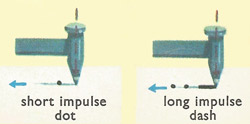 |
| Pens used for recording telegraph signals
|
 |
| A word spelled out in Morse
|
Early telegraph receivers had magnetic needles, which were deflected from a center line as each impulse arrived from the transmitter. But this meant that the person receiving the message had to watch the dial at the same time as writing down the message, and, as a result, these receivers were soon superceded by ones that emitted sounds. Short and long impulses on these are distinguished either by two different sounds or by the time that elapses between the sounds. Other receivers, like Morse's, draw dots and dashes with pens controlled by electromagnets.
Duplex, quadriplex, and multiplex
Telegraph circuits were costly to install and operate, so devices were invented to increase the message-carrying capacity of individual lines.
In the duplex system a single line carries two messages at the same time, one in each direction. This is achieved by connecting both a transmitter and a receiver at each end of a line. In the more complicated quadriplex system two messages can be sent from each end at the same time. The complicated multiplex system can handle four or more messages at a time.
A different way of increasing the capacity of a telegraph line is to feed into it a number of electric 'current' currents of different frequencies. Telegraph signals can then be superimposed on each of these carriers. The signals can be sorted out by filters at the receiving end and then routed to separate receivers for decoding.
Radiotelegraphy
Telegraphy between cities, and between countries separated by sea, was usually carried out by means of land-lines and submarine cables. This method was obviously impossible for ships at sea, and was therefore replaced by telegraph signals sent by radio (radiotelegraphy). Radiotelegraphy is less affected by distortion than radiotelephony (voice transmission), and could therefore be used when distance or atmospherics make satisfactory radiotelephonic contact impossible.
Automatic transmission
A skilled operator using a Morse key could transmit about 40 words each minute. A telegraph line could handle many more, so a single line could carry a great many messages if transmission and reception were speeded up. This was done by automatic transmission.
Messages to be transmitted were first encoded on a narrow tape of paper. The early code was based on the Morse Code, and a simple device punched two lines of holes in the paper. Two holes, one immediately above the other, represented a short impulse or dot; two holes, with the lower one to the right of the upper, represented a long impulse or dash. The completed tape was fed through a transmitter operating at several hundred words per minute. Since the transmitter could deal with tape much faster than it could be prepared, several people could use a single transmitter and line. Equally fast machines were needed to receive and record the signals. These were chiefly reperforators that prepared from the incoming impulses tape exactly like that fed into a decoding machine that produced a second tape on which the message was printed in Roman characters.
Later most automatic transmission systems used tape punched with a five-unit code, two of the holes being above and three below a line of feed holes. This system was used chiefly for transmission in submarine cables and for teleprinter services. The tape was prepared on a machine with a keyboard like a typewriter, or on a teleprinter with a special attachment. On receipt it was decoded into words in a single step, either on to a ticker tape or on to a paper roll.
Teleprinter
The teleprinter, or, as it was called in the US, the teletypewriter, was an instrument used both for the transmission and the reception of telegraph messages.
The teleprinter had a keyboard much like a typewriter. When the operator pressed a key a code combination of five units representing the letter was sent down the line to the teleprinter at the other end. This signal caused the second teleprinter to select and print the same letter on a paper ribbon.
Teleprinters could transmit directly. It was also possible to record messages on a punched tape that could then be fitted to an attachment on the teleprinter. In this way a number of messages could be prepared in advance and then transmitted without a break.
The advantages of teleprinters were that they could receive messages when they were unattended at night, and that they provide permanent written records of business arrangements that have been completed with their aid.
In many countries special telegraph networks were available to connect teleprinters. Other systems connected teleprinters to each other through the ordinary public telephone exchange. Telex was a widely used customer-to-customer switched network of teleprinters, using telegraph-grade connecting circuits for two-way text-based messages. Telex was a major method of sending written messages electronically between businesses in the post-World War II period but its usage went into decline as the fax machine grew in popularity in the 1980s.


